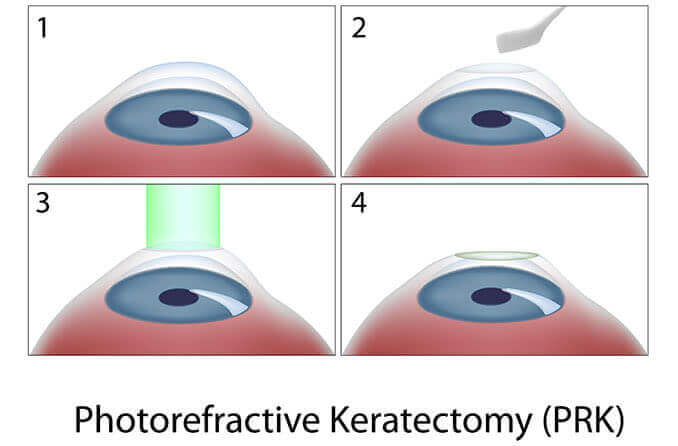PRK
PRK (photorefractive keratectomy) is the original laser refractive surgery first introduced in 1988 in the United States and is used to correct nearsightedness (myopia) farsightedness (hyperopia), astigmatism, and presbyopia, giving you freedom from glasses and contacts.

PRK is the process of removing the surface epithelial cells from the cornea and using an excimer laser to reshape the cornea so light is focused naturally on the retina. PRK was the first procedure to use the excimer laser to treat many types of refractive errors and is still the procedure of choice for many patients. During PRK, the excimer laser uses a cool ultraviolet light beam to precisely remove tissue from the surface of the cornea to reshape it. Once the cornea is reshaped, it works better to focus light through the eye and onto the retina, providing clearer vision than before. PRK differs from LASIK (Laser in Situ Keratomeleusis) and IntraLase (using the femtosecond laser to create a corneal flap) by avoiding the need to cut a flap of tissue into the corneal surface.
PRK Advantages
- PRK sculpts the outside of your cornea using an individualized laser pattern, instead of the inside.
- No incision
- No corneal flap
This makes PRK available to patients who are ineligible for LASIK surgery due to:
- Thin corneas
- Corneal scars
- Corneal dystrophy
- Recurrent corneal erosion
- Lifestyle choices (such as contact sports)
Since PRK does not involve creating a corneal flap, there are no flap complications during or after surgery – the most common problem encountered with LASIK procedures.
PRK Procedure
PRK is same-day surgery, and you will not need general anesthesia. We use numbing eye drops so that you do not have discomfort during surgery. We can give you an oral sedative if you are nervous.
- A speculum holds your eye open so that you do not blink
- The excimer laser precisely removes tissue, reshaping your cornea
- A bandage contact lens is placed on your eye
PRK is a safer procedure for most patients but requires longer recovery than LASIK. If you have PRK on both eyes you will need about 1 week to 10 days recovery before returning to usual activities such as work and driving.
